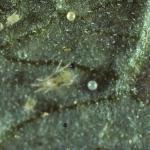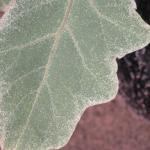Two-spotted Spider Mite
Tetranychus urticae
The two-spotted spider mite is the most common mite species that attacks vegetable and fruit crops in New England. Spider mites can occur in tomato, eggplant, potato, vine crops such as melons, cucumbers, and other crops. Two-spotted spider mites are one of the most important pests of eggplant. They have up to 20 generations per year and are favored by excess nitrogen and dry and dusty conditions. Outbreaks are often caused by the use of broad-spectrum insecticides which interfere with the numerous natural enemies that help to manage mite populations. As with most pests, catching the problem early will mean easier control.
Identification:
Adult females are tiny; they can be seen with the naked eye but a 10x hand lens is very helpful. TSSM adults are about 1/50-inch long (1/2 mm), slightly orange or pale green in color, with two dark spots on their body. Initially, mites will feed on the undersides of leaves but in heavy infestations, they will move to the tops of leaves and onto fruit. Large populations will produce visible webbing that can completely cover the leaves. Mites hide under the webbing, making them difficult to reach with sprays.
Life Cycle:
All mobile life stages—adults, larvae, and nymphs—can feed on plant tissue. Eggs are laid singly, up to 100 per female, during her 3- to 4-week life span. Eggs hatch into larvae in as few as 3 days. Following a brief larval stage, several nymphal stages occur before adults appear. Egg to adult cycle can be completed in 7-14 days depending on temperature. All life stages can survive the winter in high tunnels in New England, and adult females will overwinter outside as well.
Crop Injury:
Adult TSSM feed by sucking chlorophyll out of the leaves, creating blotchy pale to reddish-brown spots. Feeding injury often gives the top leaf surfaces a mottled or speckled, dull appearance. Leaves then turn yellow and drop. Large populations produce visible webbing that can completely cover the leaves.
In the field, spider mites are favored by hot, dry, and dusty conditions, which also aggravates injury by stressing the plant. Damage is often underestimated since the wounds and the pest are not apparent to our eyes without close inspection. Leaves become blotched with pale yellow, reddish brown spots ranging from small to large areas on both upper and lower leaf surfaces. Other symptoms caused by either severe or constant attack include distorted leaves, overall loss of plant vigor (in spite of adequate moisture and nutrition), whitening or spotting of leaves, yellowing of the plant or some of the leaves, and in some cases loss of foliage and death.
Monitoring & Thresholds:
Watch for spider mites in greenhouses where vegetable transplants are growing. Also scout eggplants in the field. Checking for mites must be done by examining foliage. Adult mites are not found on sticky cards. Mites often develop as localized infestations on particular groups of plants such as beans or tomatoes. Sample plants by turning over leaves and with a hands-free magnifier (Optivisor) or hand lens, check for the presence of spider mites as well as symptoms or webbing. Adult females are approximately 1/50-inch long, slightly orange or pale green in color with two dark spots on their body. All mobile stages are able to pierce plant tissue with their mouth-parts and remove plant fluids. Saliva injected during feeding may also cause discoloration, necrosis or abnormalities on leaves, stems and fruits. Most spider mites are found on the underside of leaves. A 10X hand lens is key for identifying the mite species, but injury, webbing, and the tiny adults can be seen with the naked eye.
Cultural Controls & Prevention:
-
Avoid weedy fields and do not plant eggplant adjacent to legume forage crops.
-
Avoid early season, broad-spectrum insecticide applications for other pests.
-
Do not over-fertilize. Outbreaks may be worsened by excess nitrogen fertilization.
-
Overhead irrigation or prolonged periods of rain can help reduce populations.
Biological Controls:
Preventative releases of the predatory mite, Phytoseiulus persimilis, may suppress TSSM populations in greenhouses and vegetable fields, as they do in strawberry fields. Amblyseius fallicis is a predatory mite that is widely used in greenhouses. See New England Vegetable Guide on biological control in greenhouse bedding plants, Table 25. See also the New England Vegetable Guide for Table 18: Scouting and Biological Control Guidelines for Vegetable Transplants.
Chemical Controls & Pesticides:
For control, use selective products whenever possible. Selective products which have worked well in the field include:
- bifenazate (Acramite): Group UN, a long residual nerve poison
- abamectin (Agri-Mek): Group 6, derived from a soil bacterium
- spirotetramat (Movento): Group 23, mainly affects immature stages
- spiromesifen (Oberon 2SC): Group 23, mainly affects immature stages
OMRI-listed products include:
- insecticidal soap (M-Pede)
- neem oil (Trilogy)
- soybean oil (Golden Pest Spray Oil)
With most miticides (excluding bifenazate), make 2 applications, approximately 5-7 days apart, to help control immature mites that were in the egg stage and protected during the first application. Alternate between products after 2 applications to help prevent or delay resistance.
For current information on production methods (including varieties, spacing, seeding, and fertility), weed, disease, and insect management, please visit the New England Vegetable Management Guide.
Crops that are affected by this insect:
- Beans, Snap, Dry, and Lima
- Celery
- Cucumber, Muskmelon, and Watermelon
- Pepper
- Pumpkin, Squash, and Gourds
- Tomato, Field
- Tomato, Greenhouse
Sources: 2010-2011 New England Vegetable Management Guide; Watch for Spider Mites in Eggplant, Tomato, and Vine Crops, Ruth Hazzard, UMass Extension; Two Spotted Spider Mites on High Tunnel Vegetables, Gale Hermenau, Delaware Weekly Crop Update, June 21, 2019; Significant Crop Losses on Pepper Due to Broad Mites, Judson Reid, Cornell VegEdge, August 7, 2019; Broad Mites in Fruiting Vegetables, Steve Bogash, Penn State Extension
The Center for Agriculture, Food and the Environment and UMass Extension are equal opportunity providers and employers, United States Department of Agriculture cooperating. Contact your local Extension office for information on disability accommodations. Contact the State Center Director’s Office if you have concerns related to discrimination, 413-545-4800 or see ag.umass.edu/civil-rights-information.

